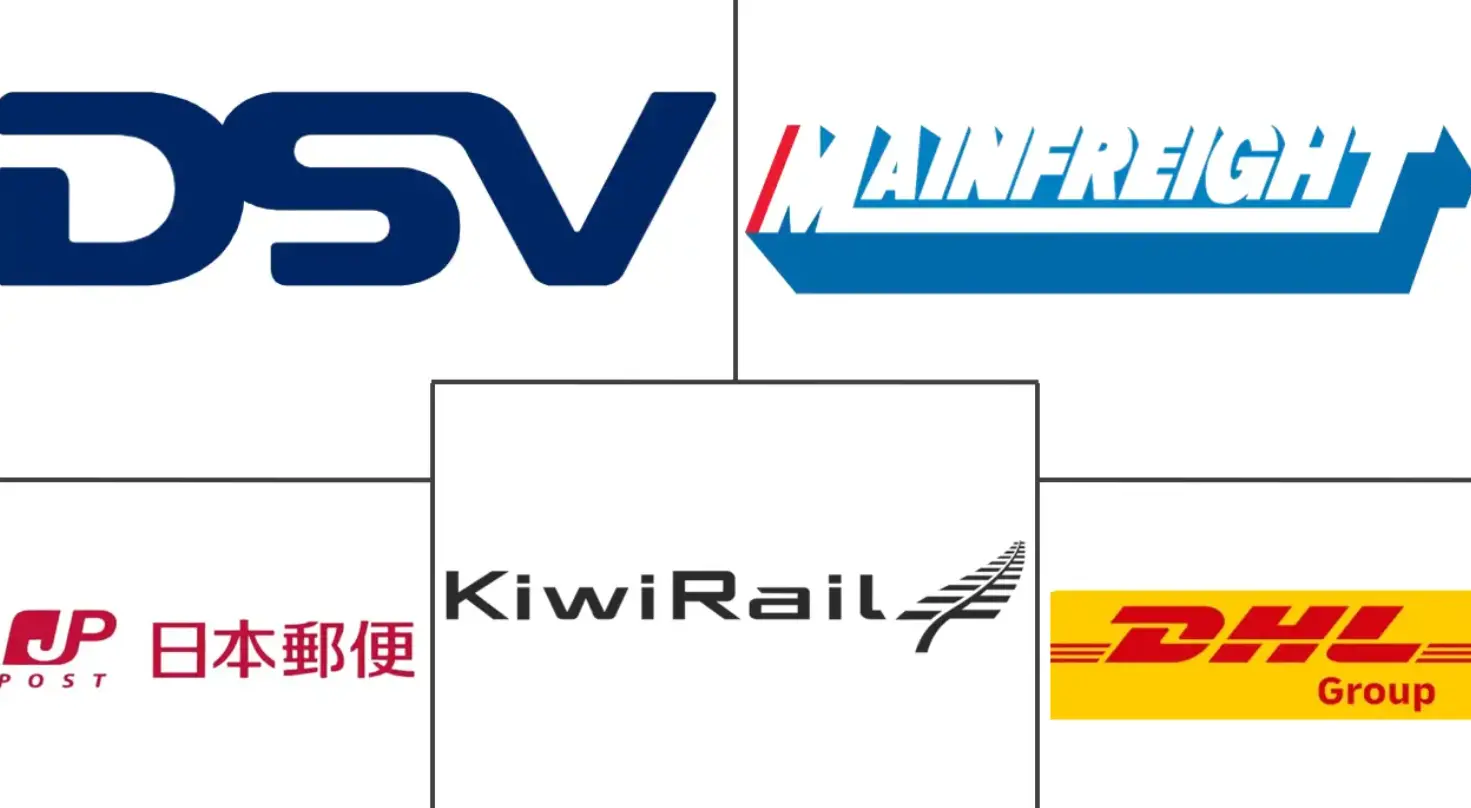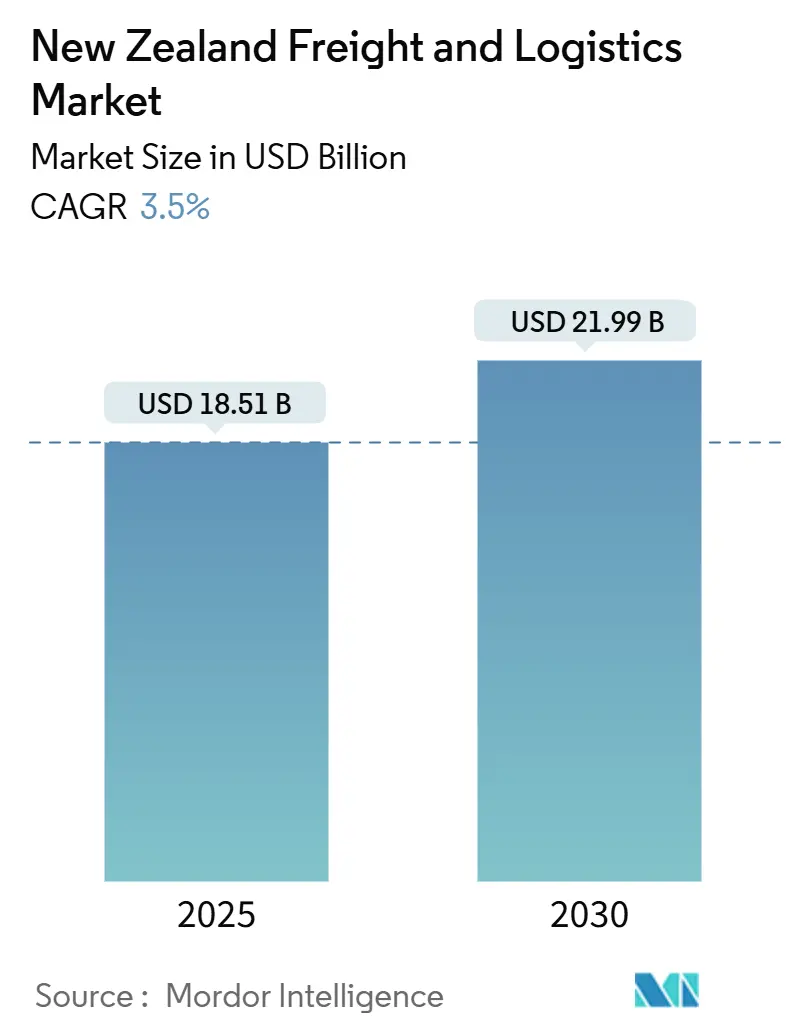
New Zealand Freight And Logistics Market Analysis by Mordor Intelligence
The New Zealand freight and logistics market size is estimated at USD 18.51 billion in 2025, and is expected to reach USD 21.99 billion by 2030, at a CAGR of 3.5% during the forecast period (2025-2030). Robust infrastructure spending, fast-rising e-commerce volumes, and a renewed policy focus on supply-chain resilience keep the growth trajectory firmly positive for the New Zealand freight and logistics market. Continuous digitalization of warehousing, rising adoption of multimodal solutions, and the country’s farm-to-port export orientation collectively underpin demand for dependable freight services. At the same time, carbon-reduction targets and new modal‐shift incentives are triggering investment in rail and coastal shipping capacity, nudging the New Zealand freight and logistics market toward lower-emission transport mixes. Although the sector remains fragmented, recent high-profile mergers and rising automation capex signal the entrance of a more efficiency-driven competitive phase.
Key Report Takeaways
- By logistics function, freight transport led with 65.25% of New Zealand's freight and logistics market share in 2024; Courier, Express and Parcel (CEP) services are forecast to advance at a 4.03% CAGR between 2025-2030.
- By end user industry, wholesale and retail trade commanded 33.81% share of the New Zealand freight and logistics market size in 2024, while manufacturing is projected to grow at 4.10% CAGR between 2025-2030.
- By CEP type, domestic parcels accounted for a 63.04% revenue share in 2024; international parcels are expected to expand at a 4.16% CAGR between 2025-2030.
- By freight forwarding mode, sea and inland waterways handled 69.15% revenue share in 2024; air freight forwarding is projected to register the fastest 4.03% CAGR between 2025-2030.
- By freight transport mode, road freight transport retained a 67.95% revenue share in 2024, whereas air freight transport is projected for a 4.50% CAGR between 2025-2030.
- By warehousing and storage, non-temperature controlled space represented 91.85% revenue share in 2024; temperature controlled facilities are expected to advance at a 3.99% CAGR between 2025-2030.
New Zealand Freight And Logistics Market Trends and Insights
Drivers Impact Analysis
| Driver | (~) % Impact on CAGR Forecast | Geographic Relevance | Impact Timeline |
|---|---|---|---|
| Climate resilience and infrastructure adaptation initiatives driving growth | +0.8% | Auckland, Wellington, Christchurch | Short term (≤ 2 years) |
| Government’s NZD 7 billion (~USD 4.65 billion) p.a. transport infrastructure in pipeline | +1.2% | Nationwide; Auckland-Hamilton-Tauranga corridor | Medium term (2-4 years) |
| Diversification of agri-food export trade lanes witnessed | +0.4% | Canterbury, Waikato, Bay of Plenty | Long term (≥ 4 years) |
| Rapid adoption of warehouse automation and digital freight platforms | +0.6% | Major urban centers | Medium term (2-4 years) |
| Cook Strait resilience push driving multimodal growth | +0.3% | North-South Island connectivity | Long term (≥ 4 years) |
| Carbon-pricing accelerating shift to rail and coastal shipping | +0.2% | Nationwide | Long term (≥ 4 years) |
| Source: Mordor Intelligence | |||
Climate Resilience and Infrastructure Adaptation Initiatives Driving Growth
The National Adaptation Plan compels every large transport project to embed climate-risk criteria, elevating resilience from a design option to an approval prerequisite[1]“National Adaptation Plan,” Ministry for the Environment, environment.govt.nz. Auckland’s 2023 floods underscored the economic cost of route closures and port downtime, pushing private operators to invest in redundant capacity and elevated facility designs. Port of Tauranga has retrofitted cargo-handling areas with flood-resistant equipment, safeguarding berth productivity during storm surges. Insurance premiums on exposed assets are climbing, thereby incentivizing logistics firms to accelerate protective capital expenditure. The cumulative effect is a measurable improvement in network uptime and a shift toward asset-light contingency services able to route freight around climate-affected corridors.
Government's NZD 7 Billion (~USD 4.65 Billion) Transport Infrastructure in Pipeline
The 2025 Budget allocates NZD 6.8 billion (USD 4.3 billion) to logistics-relevant projects, including NZD 464 million (USD 293 million) earmarked for rail track renewal in the Auckland and Wellington corridors[2]“Investing in infrastructure for all New Zealanders,” New Zealand Government, beehive.govt.nz. Grade-separated highways under the Roads of National Significance program ease heavy-vehicle congestion, lowering operating costs and pushing payload efficiency higher. Integrated nodes such as the NZD 1.5 billion (USD 0.95 billion) Melling project bundle freight access and public-transport provisions into single schemes, shortening project lead times and amplifying network capacity[3]“Melling transport improvements to start this year,” New Zealand Government, beehive.govt.nz. Collectively, the pipeline is expected to shave transit times on critical corridors by up to 15%, directly supporting New Zealand's freight and logistics market competitiveness. Private operators, encouraged by clearer forward workstreams, have accelerated fleet renewal, with a noticeable uptick in low-emission truck orders.
Diversification of Agri-Food Export Trade Lanes Witnessed
Heightened geopolitical risk and changing consumer demand patterns are prompting exporters to widen destination portfolios beyond traditional East-Asian and North-American buyers. Container throughput at Port of Tauranga climbed 17% in 2024 to 292,860 TEUs, with emerging Southeast-Asian lanes contributing the bulk of incremental volumes. Cold-chain demand is rising in parallel; specialized storage capacity is witnessing a near-4% annual run-rate as high-value horticultural and premium meat exports proliferate. Exporters are adopting traceability tech and smart packaging, boosting demand for data-ready logistics services that can guarantee provenance and cold-chain integrity during longer voyages.
Rapid Adoption of Warehouse Automation and Digital Freight Platforms
Labor shortages and e-commerce order spikes have turbocharged automation investment. AS Colour’s Multishuttle deployment generated a 344% productivity gain, validating high-throughput goods-to-person models. Cardinal Logistics’ new ASRS site lifted order output fourfold while improving safety metrics. Payback periods are shortening as capital costs fall and financing solutions multiply. Parallel growth in digital freight marketplaces is expanding spot-rate transparency and dynamic routing options, allowing smaller shippers to secure capacity previously available only to larger accounts. Data-driven operations are therefore narrowing the efficiency gap between large and mid-tier market participants.
Restraints Impact Analysis
| Restraint | (~) % Impact on CAGR Forecast | Geographic Relevance | Impact Timeline |
|---|---|---|---|
| Geographic isolation inflating ocean freight costs in New Zealand | -0.5% | Nationwide | Long term (≥ 4 years) |
| Driver shortage and ageing workforce impacting market efficiency | -0.4% | Auckland, Canterbury | Short term (≤ 2 years) |
| Rising insurance premiums after climate-event losses | -0.2% | Flood-prone regions | Medium term (2-4 years) |
| Volcanic and seismic disruption risk to key logistics hubs | -0.1% | Auckland, Wellington, Canterbury | Long term (≥ 4 years) |
| Source: Mordor Intelligence | |||
Geographic Isolation is Inflating Ocean Freight Costs
Being 1,800 km from its nearest major neighbor, New Zealand relies on ocean transport for 99% of trade by volume. Limited carrier competition and long transit times hardwire higher freight expenditure into supply chains, eroding margin headroom for exporters. New mega-alliances formed in 2025 now control around 80% of global container capacity, making rate volatility and capacity rollovers more acute for New Zealand shippers. Container imbalances linked to export-heavy flows further raise repositioning costs, while schedule recovery options remain scarce. The cumulative effect trims forecast growth for the New Zealand freight and logistics market by half a percentage point.
Driver Shortage and Aging Workforce Impacting Market Efficiency
Road freight transport, which still moves 67.95% of freight by value in 2024, faces an acute driver deficit as the average driver age tops 60 years, and fewer than 7% of drivers are under 25. Even after licensing reforms eliminated secondary practical tests, recruitment remains slow. Wage inflation and sporadic service disruptions elevate delivery costs and dampen the reliability metrics crucial for just-in-time inventory models. Fleet operators are responding with telematics-enabled safety programs and automation pilots, yet near-term labor tightness continues to cap capacity growth.
Segment Analysis
By End User Industry: Retail Trade’s Scale Meets Manufacturing’s Momentum
Wholesale and retail trade contributed 33.81% of the New Zealand freight and logistics market size in 2024, reflecting the growing intricacy of omnichannel distribution networks and nationwide consumer penetration. E-commerce parcel counts surpassed 190 million in 2024 on NZ Post’s network expansions, adding last-mile density and driving warehouse localization strategies. Inventory repositioning nearer to urban clusters improved order cycle times but increased the number of intra-city freight movements, elevating CEP demand. The food retail subset links directly to cold-chain investments, encouraging cross-segment collaborations in warehousing and refrigerated transport.
Manufacturing, albeit a smaller contributor in 2024, is expected to register the market’s swiftest 4.10% CAGR expansion between 2025-2030. Government incentives for advanced manufacturing and value-added food processing are lifting the outbound tonnage of processed goods that command premium freight services. Automation in production lines mirrors warehouse digitization, requiring synchronized logistics scheduling to capture efficiency gains. Suppliers are adopting vendor-managed inventory programs, causing freight flows to become more predictable yet more time-sensitive. As policy shifts encourage higher local value capture, freight intensity per dollar of output is rising, deepening the sector’s engagement with the New Zealand freight and logistics market.
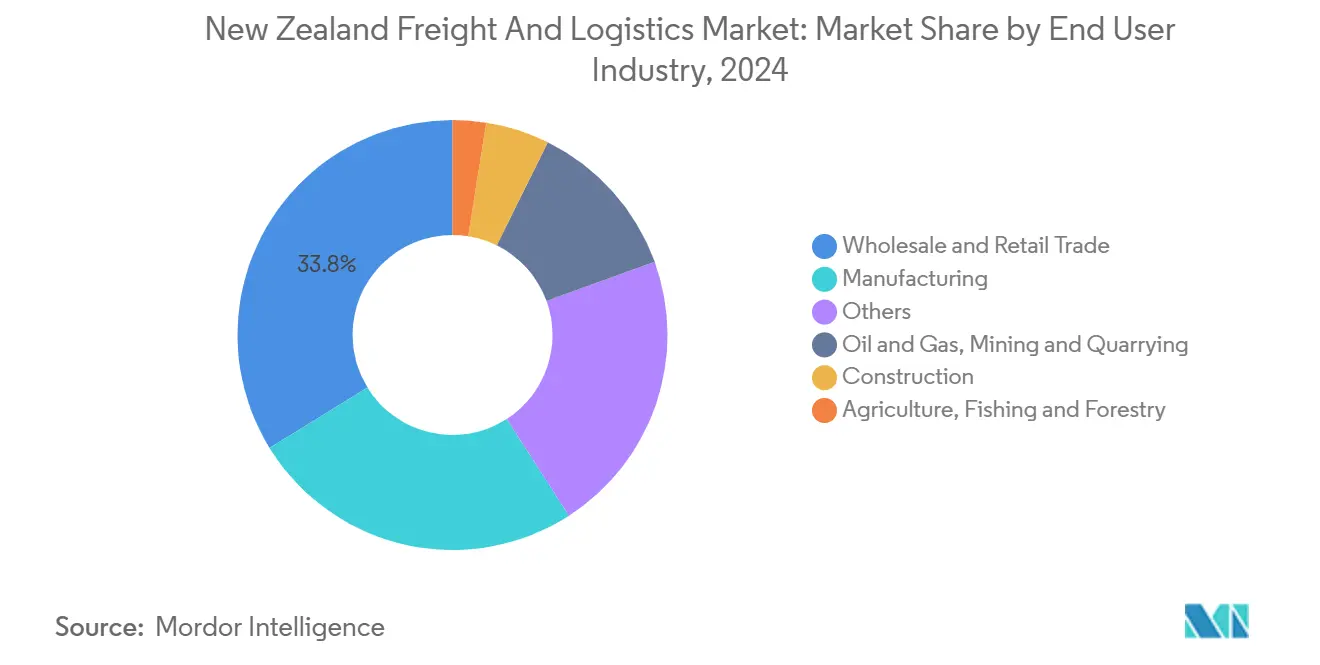
Note: Segment shares of all individual segments available upon report purchase
By Logistics Function: Freight Transport Dominance Under E-commerce Pressure
Freight Transport retained 65.25% of New Zealand's freight and logistics market share in 2024, anchored by bulk movement of goods to ports and metropolitan distribution hubs. Price-sensitive exporters continue to rely on full-truckload and intermodal solutions that combine road and sea legs, benefiting operators capable of orchestrating integrated networks. Road-to-port shuttles remain the linchpin, yet modal diversification is gathering pace as carbon-pricing reorders cost hierarchies.
Courier, Express and Parcel activity, however, is expected to advance at 4.03% CAGR (2025-2030), absorbing surging B2C volumes and rising SME cross-border export transactions. Automated sorting hubs with hourly throughputs above 30,000 parcels exemplify the scale of investment now flowing into CEP infrastructure. Competitive differentiation revolves around delivery-time guarantees and real-time visibility dashboards, compelling incumbents to partner with digital platforms and fine-tune last-mile routing algorithms. The dual speed of freight growth is thereby reshaping the revenue mix for integrated logistics providers that straddle multiple service silos.
By Courier, Express, and Parcel (CEP): Domestic Networks, Anchor International Upside
Domestic CEP services captured a 63.04% revenue share in 2024, driven by a dispersed population and the cost advantages of centralized processing. Rural delivery remains a structural challenge, prompting fleet allocations of smaller vans and drone-delivery trials for remote areas. Service providers balance coverage obligations against profitability by employing zonal pricing and rural delivery days.
International CEP, buoyed by marketplace integrations that simplify customs paperwork, is forecast to post a 4.16% CAGR (2025-2030), eclipsing domestic growth rates. Enhanced offerings such as FedEx International Connect Plus provide 1-3-day delivery to Europe, unlocking higher-margin lanes. Regulatory harmonization through trade agreements is loosening friction, yet capacity management at origin gateways remains critical during peak export seasons. Providers capable of aligning outbound parcel flows with inbound returns are well-positioned to capture scale efficiencies as international volumes rise.
By Warehousing and Storage: Non-Temperature Controlled Dominates, but Temperature Controlled Grows
Non-temperature controlled made up 91.85% of the segment revenue in 2024. Third-party logistics providers continue to automate pallet handling and deploy ASRS to compress operating costs and raise reliability. The New Zealand freight and logistics market benefits from these productivity gains as service quality lifts without proportional headcount growth.
Temperature controlled warehousing, projected to expand at a 3.99% CAGR (2025-2030), is riding a surge in premium dairy, meat, and horticultural exports, alongside heightened pharmaceutical storage needs. Alliance Group’s NZD 16 million (USD 10.1 million) automation retrofit demonstrates the capital committed to maintaining quality across longer global journeys. Sensor-based monitoring and traceability mandates elevate the technological bar, rewarding operators who integrate real-time temperature analytics into standard workflows.
By Freight Transport: Road Freight Transport Hegemony Faces Modal-Shift Incentives
Road freight transport handled 67.95% of the revenue share in 2024, with per-ton-km pricing at USD 0.194 in 2024. Network density and door-to-door flexibility keep roads indispensable, especially for intra-island distribution. Yet escalating driver shortages and carbon taxes are chipping away at its cost advantage. Fleet operators are piloting alternative fuels and advanced driver-assistance systems to curb emissions and mitigate labor gaps.
Air freight transport leads growth at 4.50% CAGR (2025-2030), catalyzed by time-critical export demand and cross-border e-commerce imports. Rate differentials versus sea freight are narrowing for select high-value commodities, spurring modal conversion. Rail and coastal shipping are acquiring a new share as carbon-pricing tilts total landed cost calculations. KiwiRail’s data shows avoidance of 229,000 tons of CO₂ emissions in the first half of 2024, supporting corporate ESG scorecards. Multimodal route planners, therefore, are recalibrating mode splits to capitalize on emerging incentives.
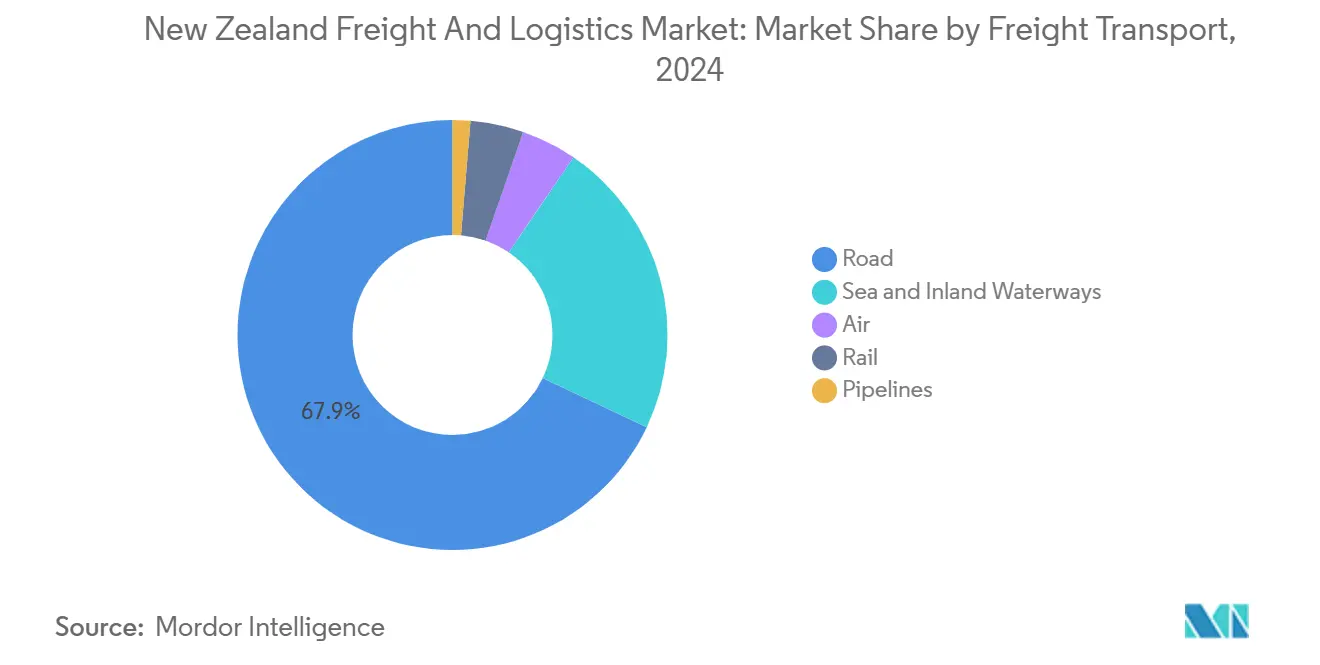
Note: Segment shares of all individual segments available upon report purchase
By Freight Forwarding: Sea and Inland Waterways Scale Meets Air’s Velocity
Sea and inland waterways freight forwarding accounted for 69.15% of the segment revenue share in 2024 as exporters leveraged favorable cost per ton-km economics. Consolidation around mega-alliances signals more standardized service windows, yet smaller shippers still face equipment availability challenges on backhaul legs. Value-added services, including origin consolidation and export documentation pre-clearance, are now table stakes for forwarders seeking to retain client stickiness.
Air freight forwarding is projected to expand at a 4.03% CAGR (2025-2030), benefits from the premium-product thrust of agri-food and pharmaceutical exporters. Global air-cargo capacity constraints have eased since mid-2024, and forwarders with block-space agreements capture rate stability advantages. Integrated temperature-controlled handling and visibility tech are core differentiators, particularly for high-value perishables with narrow shelf-life tolerances. Growth in this segment underscores the widening service spectrum defining the New Zealand freight and logistics market.
Geography Analysis
New Zealand’s elongated dual-island topography molds freight flows into a north-south axis centered on the Auckland–Hamilton–Tauranga triangle. This corridor hosts the highest GDP density and accommodates most import flows, making it the fulcrum of the New Zealand freight and logistics market. Auckland’s constrained port footprint amplifies reliance on road shuttles to inland depots, intensifying congestion at peak periods. Planned highway upgrades and rail-freight improvements are expected to unlock latent capacity, yet land-use conflicts remain a brake on rapid expansion.
Wellington occupies a strategic midpoint role as political capital and as the Cook Strait choke-point. Ferry capacity limitations today force scheduling buffers into inter-island logistics plans, reducing asset utilization. The two newly ordered rail-capable ferries will extend deck capacity and simplify wagon transfers, enabling freight operators to treat the islands as a more contiguous network once commissioned[4]“New ferries will restore resilient Cook Strait connection,” New Zealand Government, beehive.govt.nz. The change is forecast to incrementally lift the rail’s share of the New Zealand freight and logistics market.
South Island logistics revolve around Christchurch’s multimodal hub, serving primary-industry clusters across Canterbury and Otago. DHL’s carbon-neutral gateway there expands international CEP throughput to 6,500 inbound parcels per hour, underlining corporate confidence in South Island growth prospects. Port diversification strategies centered on smaller harbors such as Northport and Timaru seek to relieve pressure on Tauranga and Auckland during peak export months. Government infrastructure-resilience plans further encourage multi-port redundancy to hedge seismic and flood risks, fostering a more distributed network topology across the New Zealand freight and logistics market.
Competitive Landscape
International forwarders and domestic carriers share a moderately fragmented arena where technology adoption differentiates performance. DSV’s EUR 14.3 billion (USD 15.8 billion) purchase of DB Schenker vaults the Danish group to global leadership and fortifies its presence in air and sea lanes serving New Zealand. Such scale advantages allow deeper digital investments, from AI-driven booking engines to predictive ETA models, elevating service expectations across the market.
Local champion Mainfreight retains niche strengths in integrated trans-Tasman services but reported a profit dip in 2024 as wage inflation and automation capex weighed on margins. Domestic road specialists are responding with fleet connectivity upgrades and driver-wellness programs to stem attrition. Automation pioneers such as Cardinal Logistics showcase the productivity leap attainable with ASRS, narrowing the cost gap against scale challengers.
Sustainability emerges as a competitive axis. Operators highlighting low-carbon transit modes and verifiable emissions reporting gain traction with export clients subject to Scope 3 disclosure. CMA CGM’s AI partnership with Google exemplifies how carriers seek digital solutions to optimize routing and cut fuel burn. Altogether, technology convergence and environmental mandates are pushing the New Zealand freight and logistics market toward a more capability-driven hierarchy.
New Zealand Freight And Logistics Industry Leaders
-
Mainfreight, Ltd.
-
DHL Group
-
Japan Post Co., Ltd. (Including Toll Group)
-
KiwiRail Holdings, Ltd.
-
DSV A/S (Including DB Schenker)
- *Disclaimer: Major Players sorted in no particular order
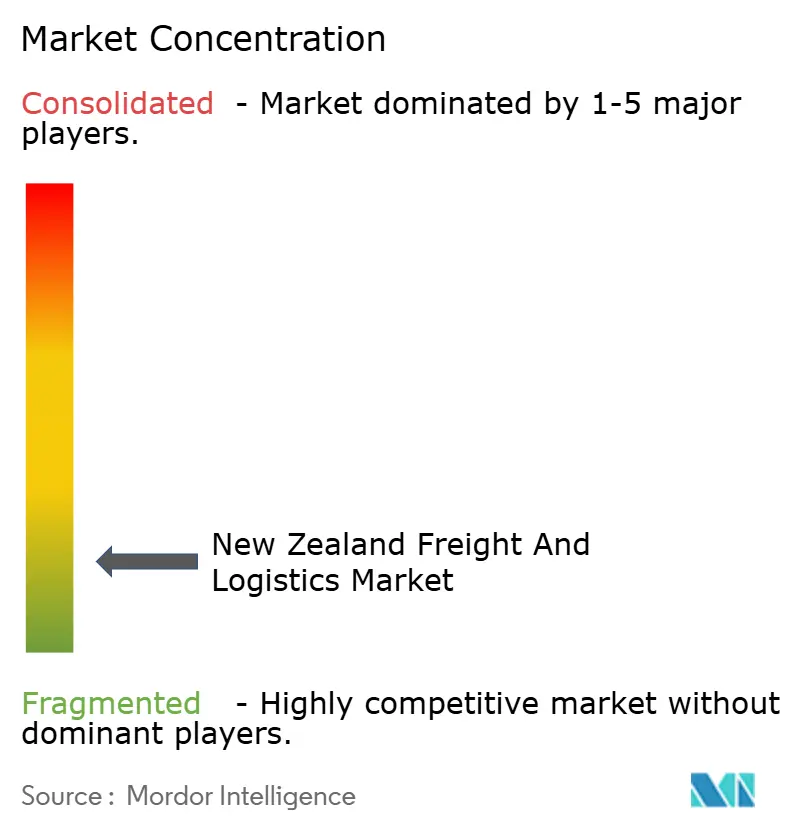


Recent Industry Developments
- April 2025: DSV closed its EUR 14.3 billion (USD 15.8 billion) acquisition of DB Schenker, creating the world’s largest freight forwarder by revenue.
- March 2025: DHL Express unveiled a 100% carbon-neutral gateway in Christchurch, boosting parcel processing capacity to 6,500 inbound and 5,600 outbound parcels hourly.
- October 2024: Cardinal Logistics launched its first automated warehouse using ASRS and goods-to-person technologies, quadrupling order output.
- April 2024: NZ Post opened the country’s largest parcel hub under its NZD 200 million (USD 126.4 million) Te Iho program, lifting annual processing capacity to 190 million parcels.
New Zealand Freight And Logistics Market Report Scope
Freight and logistics refer to the transportation of goods in the domestic and international markets via various modes of transportation, including air, rail, and roadways.
The report includes a complete background analysis of the New Zealand freight and logistics market, including an assessment of the economy and the contribution of sectors to the economy, a market overview, market size estimation for key segments, emerging trends in the market segments, market dynamics, and geographical trends.
The New Zealand Freight and Logistics Market is segmented by function (freight transport [air, shipping, and inland water, road, and rail], freight forwarding, warehousing, and value-added services and other functions) and end-user (manufacturing and automotive, oil and gas, mining, and quarrying, agriculture, fishing, and forestry, construction, distributive trade [wholesale and retail], and other end users [telecommunication, pharmaceuticals, and F&B]).
The report offers market size and forecasts for the New Zealand freight and logistics market in terms of value (USD) for all the above segments.
| Agriculture, Fishing, and Forestry |
| Construction |
| Manufacturing |
| Oil and Gas, Mining and Quarrying |
| Wholesale and Retail Trade |
| Others |
| Courier, Express, and Parcel (CEP) | By Destination Type | Domestic |
| International | ||
| Freight Forwarding | By Mode of Transport | Air |
| Sea and Inland Waterways | ||
| Others | ||
| Freight Transport | By Mode of Transport | Air |
| Pipelines | ||
| Rail | ||
| Road | ||
| Sea and Inland Waterways | ||
| Warehousing and Storage | By Temperature Control | Non-Temperature Controlled |
| Temperature Controlled | ||
| Other Services | ||
| End User Industry | Agriculture, Fishing, and Forestry | ||
| Construction | |||
| Manufacturing | |||
| Oil and Gas, Mining and Quarrying | |||
| Wholesale and Retail Trade | |||
| Others | |||
| Logistics Function | Courier, Express, and Parcel (CEP) | By Destination Type | Domestic |
| International | |||
| Freight Forwarding | By Mode of Transport | Air | |
| Sea and Inland Waterways | |||
| Others | |||
| Freight Transport | By Mode of Transport | Air | |
| Pipelines | |||
| Rail | |||
| Road | |||
| Sea and Inland Waterways | |||
| Warehousing and Storage | By Temperature Control | Non-Temperature Controlled | |
| Temperature Controlled | |||
| Other Services | |||


Key Questions Answered in the Report
How large is the New Zealand freight and logistics market in 2025?
The market is valued at USD 18.51 billion in 2025 and is projected to reach USD 21.99 billion by 2030.
Which logistics function currently leads sector revenue?
Freight Transport commands a 65.25% share in 2024, reflecting the critical role of bulk and containerized moves across the country.
What segment is growing fastest through 2030?
Courier, Express, and Parcel services are forecast to grow at a 4.03% CAGR (2025-2030) as e-commerce volumes surge.
How is government infrastructure spending influencing growth?
A NZD 7 billion (USD 4.65 billion) annual pipeline is reducing transit times and boosting multimodal capacity and industry CAGR.
Why is temperature-controlled warehousing seeing investment?
Diversifying agri-food exports and tighter pharmaceutical standards are driving a 3.99% CAGR (2025-2030) in cold-chain storage demand.
What is the outlook for rail freight?
Rail gains momentum from carbon-pricing incentives and upcoming Cook Strait rail-capable ferries, reinforcing its role in a more sustainable transport mix.
Page last updated on:
